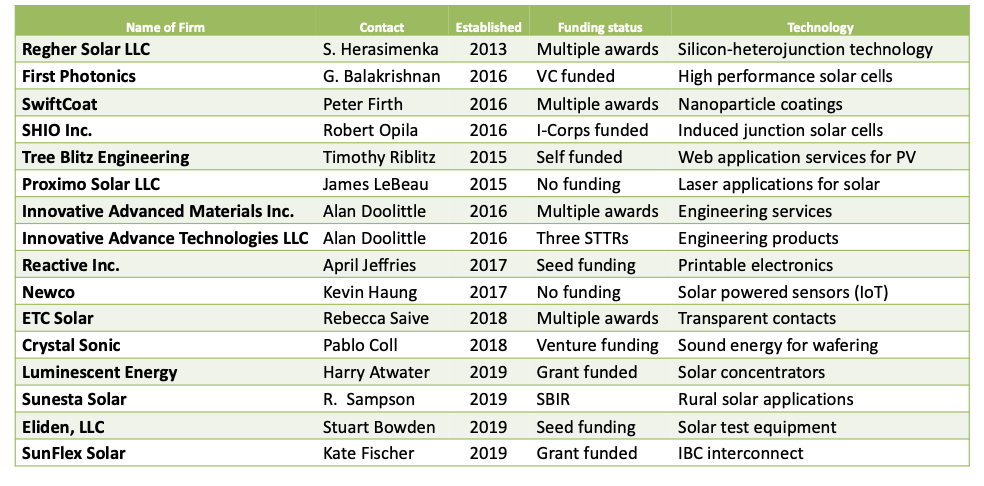PV Foundry Transitions QESST Research Breakthroughs to Commercial Space
Outcome/Accomplishment
TheQuantum Energy and Sustainable Solar Technologies (QESST) Engineering Research Center (ERC) at Arizona State University (ASU) has successfully established a community ecosystem for solar photovoltaics (PV) through its technological advancements. The ERC's in-house, research-based incubator program through the Solar Power Laboratory and the PV Foundry, have spun-off a total of 16 companies to date, many of which are still active or evolving as commercial enterprises. The QESST ERC is sponsored by the National Science Foundation (NSF).
Impact/Benefits
The Terawatt Challenge calls for the generation of clean, renewable energy to meet growing global demand, specifically seeking to increase energy output by a minimum factor of two by 2050. The PV technologies developed through the research conducted by QESST can sustainably and rapidly scale to meet this challenge while simultaneously achieving performance increases and cost reduction. Analysts foresee installed power capacity from PV innovations to surpass both natural gas and coal as early as 2027. Solar PV innovations are also stimulating economic development. A report by Precedence Research estimated the 2021 global PV market at nearly $US160 billion and predicted it will reach over $US250 billion by 2030. The market is poised to grow at a compound annual growth rate (CAGR) of 5.1 percent by 2030. Amidst this transition, the Solar Power Laboratory based at ASU has firmly established itself as a national resource for viable PV innovations, with demonstrated economic and environmental impacts now being directly achieved through the unique pilot line of the QESST ERC's PV Foundry. This work supports the emergence of green energy as well as grid resilient and climate adaptive systems.
Explanation/Background
In the initial phase of its work, the vision of the QESST ERC was focused on developing the emerging PV ecosystem, with attention paid to new solar cell design, manufacturing processes, education, and innovation. A goal is to reduce the levelized cost of energy (LCOE) of US-manufactured solar cells while accelerating US PV manufacturing.
Through its partnership with the Georgia Institute of Technology, the QESST ERC leverages both the research findings emerging from the Solar Power Lab and the manufacturing capabilities of the PV Foundry to support the development of its spin-out companies and new business models. The Solar Power Lab and PV Foundry provide state-of-the-art facilities, institutional support, and industry collaboration opportunities to serve as an optimized staging ground for new ideas and technologies. The PV Foundry enables full wafer fabrication and testing capabilities of current state-of-the-art passivated contact technology as well as education programs that focus on manufacturing and training for operators and process engineers to achieve commercialization of PV innovations.
Between 2013 and 2019, the PV Foundry at the QESST ERC supported the launch of 16 incubator companies spun-off from QESST investigators. Of these companies, four received multiple funding awards, two were grant funded, two received venture capital funding, and four received small business seed funding.
Location
Tempe, Arizonawebsite
Start Year
Energy and Sustainability
Energy, Sustainability, and Infrastructure
Lead Institution
Core Partners
Fact Sheet
Outcome/Accomplishment
TheQuantum Energy and Sustainable Solar Technologies (QESST) Engineering Research Center (ERC) at Arizona State University (ASU) has successfully established a community ecosystem for solar photovoltaics (PV) through its technological advancements. The ERC's in-house, research-based incubator program through the Solar Power Laboratory and the PV Foundry, have spun-off a total of 16 companies to date, many of which are still active or evolving as commercial enterprises. The QESST ERC is sponsored by the National Science Foundation (NSF).
Location
Tempe, Arizonawebsite
Start Year
Energy and Sustainability
Energy, Sustainability, and Infrastructure
Lead Institution
Core Partners
Fact Sheet
Impact/benefits
The Terawatt Challenge calls for the generation of clean, renewable energy to meet growing global demand, specifically seeking to increase energy output by a minimum factor of two by 2050. The PV technologies developed through the research conducted by QESST can sustainably and rapidly scale to meet this challenge while simultaneously achieving performance increases and cost reduction. Analysts foresee installed power capacity from PV innovations to surpass both natural gas and coal as early as 2027. Solar PV innovations are also stimulating economic development. A report by Precedence Research estimated the 2021 global PV market at nearly $US160 billion and predicted it will reach over $US250 billion by 2030. The market is poised to grow at a compound annual growth rate (CAGR) of 5.1 percent by 2030. Amidst this transition, the Solar Power Laboratory based at ASU has firmly established itself as a national resource for viable PV innovations, with demonstrated economic and environmental impacts now being directly achieved through the unique pilot line of the QESST ERC's PV Foundry. This work supports the emergence of green energy as well as grid resilient and climate adaptive systems.
Explanation/Background
In the initial phase of its work, the vision of the QESST ERC was focused on developing the emerging PV ecosystem, with attention paid to new solar cell design, manufacturing processes, education, and innovation. A goal is to reduce the levelized cost of energy (LCOE) of US-manufactured solar cells while accelerating US PV manufacturing.
Through its partnership with the Georgia Institute of Technology, the QESST ERC leverages both the research findings emerging from the Solar Power Lab and the manufacturing capabilities of the PV Foundry to support the development of its spin-out companies and new business models. The Solar Power Lab and PV Foundry provide state-of-the-art facilities, institutional support, and industry collaboration opportunities to serve as an optimized staging ground for new ideas and technologies. The PV Foundry enables full wafer fabrication and testing capabilities of current state-of-the-art passivated contact technology as well as education programs that focus on manufacturing and training for operators and process engineers to achieve commercialization of PV innovations.
Between 2013 and 2019, the PV Foundry at the QESST ERC supported the launch of 16 incubator companies spun-off from QESST investigators. Of these companies, four received multiple funding awards, two were grant funded, two received venture capital funding, and four received small business seed funding.

